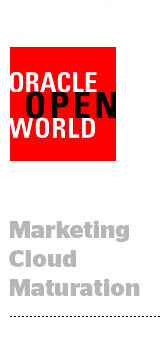 Oracle Marketing Cloud kicked off its OpenWorld conference this week with three platform features meant to reach customers across channels, improve email targeting using Datalogix and manage content marketing workflow and scheduling.
Oracle Marketing Cloud kicked off its OpenWorld conference this week with three platform features meant to reach customers across channels, improve email targeting using Datalogix and manage content marketing workflow and scheduling.
“We’re making easier for clients to operate in a cross-channel way, and we’re doing it practically, as opposed to theoretically,” said Alexander Hooshmand, Oracle Marketing Cloud’s VP of product management, of the first development, which was announced today.
The product, called Match Multiplier, is designed to bring together participating Marketing Cloud users to anonymously “pool” their capacity to identify customers across multiple channels, said John Stetic, group VP of products for Oracle Marketing Cloud.
“There is no data sharing involved,” Stetic said. “In an example, with two different marketers, their data always stays their data. There’s no modeling involved, no analytics involved. It’s really the underlying mechanics of being able to identify users across two different channels in a very privacy-sensitive, privacy-safe way.”
Oracle’s new Offline Data Append lets Marketing Cloud clients combine customer lists with Datalogix’s transaction data. For instance, a retailer running a back-to-school shopping campaign could use Append to identify and target customers in its database with a history of buying children’s clothing.
Another new feature, dubbed Business Units for Content Marketing, is designed to help enterprises scale content marketing, Stetic said. A large organization may have 20 business units, each with multiple constituents they want to reach. The tool helps users better manage scheduling, create different workflows for different units and “partition up the platform so they can more effectively scale up the operations of their content marketing activities,” Stetic said.
These enhancements help strengthen Oracle’s position in the hotly contested marketplace for digital marketing, said Gene Phifer, a VP and analyst at Gartner.
“Enterprises are striving to deliver orchestrated, cross-channel customer experiences, and the enhancements announced by Oracle today will help achieve that goal,” he said. “Intelligently combining customer lists with transaction data and taking a customer from anonymous to known improve audience segmentation and personalization, both of which are necessary for a compelling customer experience.”
Oracle has also improved the integration of the Marketing Cloud and Service Cloud platforms, which can help a brand modify its marketing activity by service history, such as whether a customer has an open support ticket.
“Most organizations have some sort of marketing system and some sort of service system,” Stetic said. “It’s still early stages for us, in the overlap of [our] customer base, but it is starting to grow.”
Moving forward, Oracle plans to continue improving the core functionality of the overall Marketing Cloud, said Stetic, who emphasized the importance of an open platform.
“You can’t operate as a closed system anymore,” he said. “We’ve invested pretty heavily to create an open platform that allows our partners, whether they’re other marketing applications, enterprise systems, data providers or media providers, to be able to easily integrate into the marketing cloud to create that open ecosystem.”












